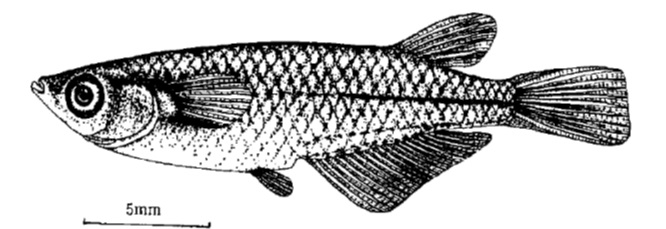
Scientists from the A.N. Severtsov Institute of Ecology and Evolution of the Russian Academy of Sciences detected a new fish species in the Rostov region in southern Russia. Molecular genetic analysis showed that these fish belong to the species of Chinese ricefish (Oryzias sinensis). This small fish, not more than 6 cm in length, is extremely fecund and capable of filling the colonized water bodies in a short time, but has no particular economic value. Genetic analysis of the material collected during the Russian-Chinese expedition to the Tibetan Plateau showed that this fish had also appeared in the upper reaches of the great Brahmaputra River; read more about this expedition in the article "Tibet: Earth's Last Pastoral": 05-14.qxd (priroda.ras.ru).

The Chinese ricefish is native to south-eastern China and some adjacent areas. New data were used to reconstruct the recent dispersal routes of this fish throughout Eurasia. Apparently, it was introduced into Tibetan and Xinjiang Uygur autonomous regions directly from eastern China. In southwestern China, in the Tibetan Plateau, Buddhist religious rites are popular, during which monks release live fish into water bodies, facilitating the spread of invasive species. The occurrence of Chinese ricefish in northwest China (in the Xinjiang Uygur Autonomous Region) is most likely due to accidental introductions in association with live economically valuable fish that are transported in large volumes of water. "Unrecorded passengers" travel in the same water and enter new areas, and this is extremely difficult to control.

From the Xinjiang Uygur region of China, the ricefish migrated along the Ili River to Kazakhstan, where numerous specimens of the species were recorded in 1970. Later, in 1974, a total of 6,200 specimens of ricefish were transported from this river to Krasnodar territory in Russia and released into six water bodies to control mosquito larvae. Apparently, the area of the new "Krasnodar" population of ricefish has expanded to water bodies of neighbouring Rostov region (as a result of self-distribution through the hydrological network and secondary unintentional local transportations together with fish material for aquaculture purposes). Ricefish from Kazakhstan was also introduced into Uzbekistan and Turkmenistan for mosquito control. Thus, step by step, this fish from southeastern Eurasia, became widely distributed.
Studies of the Chinese ricefish's expansion suggest that this southern fish species is quite resistant to cold, as it is able to establish self-sustainable populations even in the water bodies of the Tibetan Plateau and in the Rostov region of Russia. Therefore, in the conditions of global warming, further expansion of the range of this species in western China and in southern Russia, as well as its penetration into India, downstream of the Brahmaputra River, cannot be ruled out.
The research was supported by the Russian Science Foundation (project no. 21-14-00123). The results have been published in the international journal Diversity (IF3; Q1): Makhrov A.A., Artamonova V.S., Sun Y.-H., Fang Y., Pashkov A.N., Reshetnikov A.N., New records of the alien Chinese ricefish (Oryzias sinensis) and its dispersal history across Eurasia. Diversity 15(3), 317. https://doi.org/10.3390/d15030317
